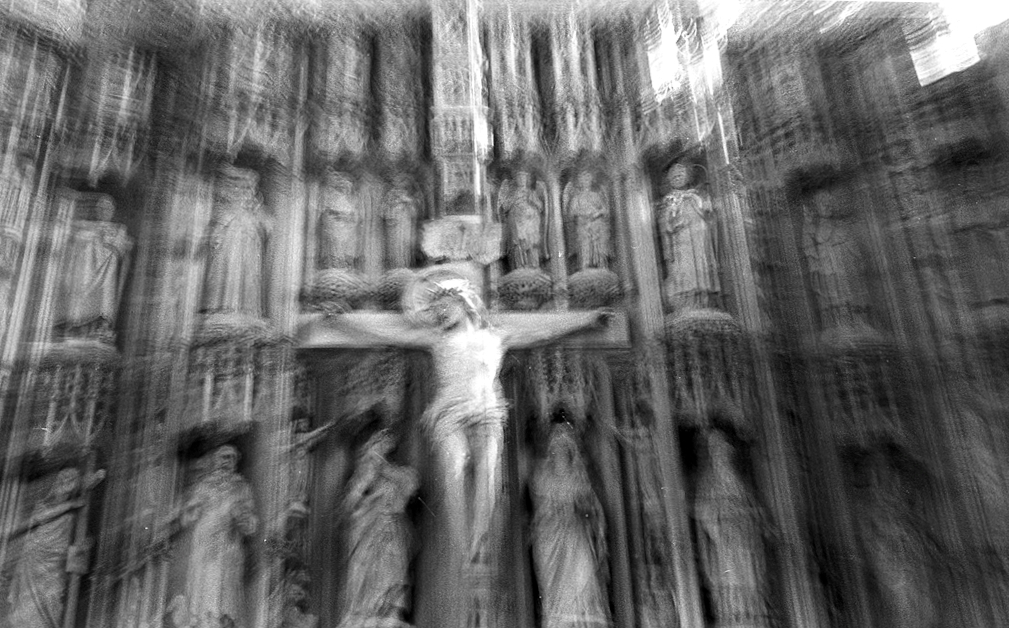
The seventh of the seven.
Some people will understand this, some will not. It may be cryptic or it may not. You may think about the image and the message and make the connection, or you may not. It is not important if it means nothing to you. The important thing is that I understand why I made the image the way I did. The purpose was to illustrate the idea and the idea is seven.
There now follows a short discourse on art history. Pay attention at the back Wrigglesworth, I’ll be asking questions afterwards.
In the Middle Ages – the medium ævum – images told stories. Religious images were didactic and churches would be decorated with paintings, sculptures and stained glass to illustrate biblical stories. Few people could read and so images became the lingua franca between the clergy and their congregations. Pictures also acted as conduits between the faithfull and the divine. Perhaps the following statement by Jean Gerson (1363-1429) sums up how mediaeval theological thought considered pictorial art: “We ought thus to learn to transcend with our minds from these visible things to the invisible, from the corporeal to the spiritual, for this is the purpose of the image”. Prayers and pleas were offered in supplication to images or relics of saints, Jesus and most of all, the virgin Mary, in the hope that the divinity would intercede with some problem or bring relief or a cure for some medical condition. The images were expected to deliver miracles. Many miracles were attributed to images or relics and these artefacts became the focus of pilgrimages. Many still are. Mediaeval superstition, perhaps? It is your choice.
Art and the patronage of the Christian church have delivered much of the intellectual culture that we enjoy today. Other religions have delivered nothing except a repeated pattern that goes nowhere and represents nothing.
I am only interested in the Art. The lush, shimmering beauty of a Simone Martini or Duccio di Buoninsegna altarpiece is a wondrous thing indeed. The molten gold glow of a Byzantine or Russian Ikon in a candlelit orthodox church can induce one to hold one’s breath and stand motionless in ecstatic admiration and silent awe. When this happens, art transcends the merely decorative and becomes divine in itself.
In the middle ages there was no such thing as ‘Art’. There were images of the divine and there were images of their stories. Art only became ‘Art’ when those who could afford it commisioned painters to make pictures to decorate their palaces and houses, many of whom were part of the clergy. This is when the so-called Donor Portrait became de rigeur for the wealthy patron. This would depict the patron – donor – praying in close proximity to one or more divine bodies. Sometimes a local saint but more usually the Virgin Mary. This would demonstrate both the donor’s piety and wealth, as well as inferring that the donor was in close proximity to the heavenly realm. Many of the patrons were part of the clergy. Rich priests with expensive tastes were not uncommon, as long as their congregations were happy to fund their expensive tastes. Thus, there was a thriving market for miraculous images and relics to keep the people happy. A church without a miraculous image or relic was a poor church. This gave rise to the ‘Furta Sacra’ whereby many a relic was stolen – or ‘translated’ – by unscrupulous priests to ensure a steady flow of affluent pilgrims to their church and a happy and generous local congregation. If they couldn’t steal them, they invented them, which is how the Turin Shroud came to be made. The most extreme case was the theft, or ‘translation’, of the supposed body of St Mark from Alexandria to Venice in 828. In 1063 a brand new cathedral was built to house the relics. Indeed, St Mark’s cathedral in Venice is nothing more or less than a gigantic Byzantine reliquary. The cathedral and its relics attracted countless pilgrims – along with their money – to Venice. Wealthy churches meant wealthy priests and a wealthy priest was a generous patron of the arts who liked nothing more than to be surrounded by beautiful, expensive things that demonstrated both his status and his refined intellect.
But there are the eyes of needles to negotiate when the final trumpets sound…
Seven is the number.
Spectacular !!
Thank you, glad you like my work.
A wonderful essay Malcolm and certainly thought provoking in it’s title. I had thought of the seventh son of the seventh son mythos, the power of seven and it’s unique mathematical significance in equal co-terminus circles, for example a honeycomb and all that bees and such constructions suggest. Man as five with his opposable thumbs, and the devil as six devoid of the final circle in the center of all the circles and of course the universal demi-urge with whom the completeness of circles and bees etc. is unraveled, in a way, a mystery in only the slightest revealed, or a clue hinted at… and yet so many more clues and insights remain: perhaps a realm of infinite insights… insights we can only continue to wonder at.
Thanks for your generous words, Wayne. Much apprciated. Indeed, the number seven has much mystical and mathematical significance. In this case it refers to words. The 7th words of the seven ‘words’ and the aftermath thereof. Or so I am told…